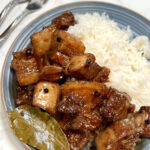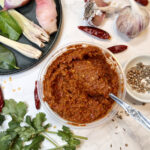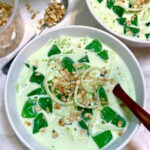Okonomiyaki is one of the most popular Japanese street foods made up of shredded cabbage and other mix-ins! It’s one of my absolute favorite ways to enjoy cabbage as a fluffy and filling meal.
Okonomiyaki: What is it?
Essentially, okonomiyaki is derived from the two Japanese words okonomi, meaning “as you like it”, and yaki, meaning “grill”.
As such, the street food is highly versatile with many variations, so long as it is fried on a griddle or a pan over direct heat.

Today we’ll be making the Osaka-style okonomiyaki, which looks like a very fluffy pancake packed with plenty of vegetables, protein, and various toppings!
Hungry for more EASY Asian recipes? Try out these trending mains:
Ingredients
(Makes 2 medium-sized okonomiyaki)
Batter:
- 45 g flour
- 3 tbsp dashi stock (can use instant dashi stock aka. Hondashi, homemade stock, or in a pinch, cold water)
- 80 g nagaimo, peeled and grated (also named Japanese mountain yam, Korean yam, or Chinese yam)
- 2 large eggs
Mix-ins:
- 200 g cabbage (can use green cabbage or napa cabbage)
- 2 tbsp green onion, chopped
- 2 tbsp beni shoga (also called Japanese red pickled ginger)
- 3 tbsp tenkasu (fried tempura bits)
Protein:
- 3-4 slices of bacon for each okonomiyaki (can substitute with mushrooms)
Toppings:
- Okonomiyaki sauce (store-bought or homemade, can also use tonkatsu sauce in a pinch)
- Kewpie mayonnaise (Japanese mayonnaise)
- Katsuobushi (dried bonito flakes)
- Aonori (dried green seaweed laver)
Homemade okonomiyaki sauce:
- 1 tbsp sugar
- 1.5 tbsp oyster sauce
- 3 tbsp Worcestershire sauce
- 3.5 tbsp ketchup
Because some of these ingredients are very Japanese-specific, I’ve compiled a list of possible substitutions and/or omissions you can make if you’re having trouble incorporating these into your okonomiyaki.
*(Note that it is a bit of a read, so only use it as a reference for when you want to make substitutions for this dish!)
Ideally, you’d want all of these ingredients for the final product, but a couple switches and omissions here and there will still make for a delicious okonomiyaki!
Ingredient notes for Okonomiyaki
Dashi
Dashi is a classic stock base used for many Japanese dishes. This is will help thin-out our batter, while giving it that signature umami and savory flavor.
- Substitutions/omissions: Dashi can be made from scratch, or for conveniency, I like to use Hondashi powder (which is essentially instant dashi). You can also substitute this for cold water.
Nagaimo
Nagaimo is a starchy root vegetable also known as Japanese mountain yam. It can also go by the names: Chinese yam or Korean yam. You can find these being sold in most asian supermarkets, cut in lengths and wrapped with plastic.
When grated, the nagaimo becomes slippery and gelatinous, giving our okonomiyaki a soft, fluffy, and custard-like texture.
- Substitutions/omissions: Certain recipes will say that nagaimo is not entirely necessary for okonomiyaki, in fact, I have had some success making okonomiyaki without it (though it was lacking that certain “bounce” and moistness that the nagaimo lends). That being said, nagaimo can be omitted, but you can also substitute it with 1/4 tsp baking powder or 1 egg white, whisked. I’ve also seen powdered nagaimo, which is another option.
Beni Shoga
Beni shoga is a red pickled ginger, typically sold refrigerated in plastic bags or containers in most Asian groceries. It has a sharp, sour flavor, which will help brighten the taste of our okonomiyaki.
- Substitutions/omissions: You can use the regular pickled ginger (the ones you eat with sushi) as a substitute, just be sure to finely slice these into thin strips. I’d imagine you could also get by with using fresh ginger, but since pickled ginger tends to have more sour/sweet notes, I’d suggest lessening the amount of fresh ginger you put into this recipe since it does have a more pungent taste.
Tenkasu
Tenkasu are crunchy bits of deep fried tempura batter; which are essentially those small scraps of batter left over in the oil whenever we deep fry something. They lend a slight crunchiness and airiness to our batter.
- Substitutions/omissions: Tenkasu can typically be found in the dried foods section of most Asian groceries. Since the flavor and textural aspect that this ingredient gives our okonomiyaki is very subtle, it can be omitted! To make this homemade, simply dribble a couple spoonfuls of the prepared okonomiyaki batter into hot oil until the bits become golden brown and crispy. Set these aside to drain and cool.
Okonomiyaki sauce
Okonomiyaki sauce is a sweet Japanese Worcestershire-type sauce. The best I could describe this is somewhat similar to the taste of barbecue sauce, but with less tang and more umami. This is one of the common toppings used for okonomiyaki.
- Substitutions/omissions: Okonomiyaki sauce can be bought in most Asian groceries packaged in small bottles. If you can’t find okonomiyaki sauce, you can also substitute it with Tonkatsu sauce, which is very similar in taste, but less sweet. I’ve included a homemade okonomiyaki sauce recipe in here as well, but also know that if you’re not a fan of sauces, this can be omitted.
Kewpie Mayonnaise
Contrary to popular belief, kewpie mayo is not the same as the standard Western mayonnaise! In short, Japanese kewpie mayonnaise typically only use the egg yolks, which is then seasoned with vinegar and other umami components. The resulting mayonnaise is richer, has a thicker and more custard-y mouthfeel, with distinct tangy and savory notes.
- Substitutions/omissions: This is one of the few exceptions where I wouldn’t recommend substituting this ingredient (since it’s so specific), but if you don’t have any other option, the closest you could work with would have to be the standard regular mayonnaise. Again, if you’re not a fan of sauces, this can be omitted.
Katsuobushi
Katsuobushi, also known as bonito flakes, are very thinly-shaved pieces of smoked skipjack tuna. These are my favorite toppings for okonomiyaki, which are packed with smoky and serious umami flavors!
- Substitutions/omissions: Katsuobushi can be found in the dried foods section of most Asian groceries, typically sealed in plastic bags. Since this ingredient is super specific, finding a proper substitute would be slightly difficult given the distinct smoky and fish flavors that this topping brings. In a pinch, you can use crushed dried seaweed or nori to give the okonomiyaki those similar umami flavors.
Aonori
Aonori is a dried and powdered seaweed, also known as green laver. It has a bright green color to it, somewhat similar to how dried parsley flakes look like.
It’s important to know that aonori and nori are not the same. They’re typically of two different species, each processed and prepared in their own ways. Taste-wise, aonori tends to be more robust, stronger, and earthier in flavor, hence why it’s typically used as a seasoning or a final garnish.
- Substitutions/omissions: Crushed or finely shredded nori can be used as a substitute, if you have no other option, however!
Instructions
Combine together the flour, dashi, and grated nagaimo in a bowl. Gently whisk to create a wet batter until just combined, then add in the eggs. Whisk again until the eggs are fully incorporated.

To the batter, add in the shredded cabbage, beni shoga, tenkasu, and green onion. Fold until evenly combined.

Heat an oiled pan over medium heat. Spread half of the okonomiyaki batter onto the pan and carefully shape it into a circle. Place 3-4 slices of bacon on top (or mushrooms), then cover with a lid and let cook for 5 minutes.


Afterwards, flip the okonomiyaki over, and continue cooking for another 5 minutes covered.
Flip the okonomiyaki over one last time, then cook for a final 2-3 minutes, uncovered, or until the batter is cooked all the way through.

Transfer to a plate, then brush on the okonomiyaki sauce, drizzle kewpie mayonnaise on top, and sprinkle katsuobushi and aonori to finish.


Serve warm and enjoy!

Final tips
- Nagaimo can cause some people to have a mild allergic reaction when the peeled vegetable touches their skin, causing them to feel itchy on their hands. I have not personally experienced this reaction, though if you want to be extra safe, you can use gloves or a plastic covering to minimize your contact with nagaimo.
- Avoid overmixing your batter to ensure a fluffy okonomiyaki! For this reason, I usually take the extra step to whisk the eggs in a separate bowl, and then mix it in with my batter. An overmixed batter tends to create dense and gummy okonomiyaki.
- To flip the okonomiyaki, you have multiple ways to do so. One way is by using two spatulas, another way is by simply flicking your wrist and flipping the okonomiyaki in the pan (I have not mastered this yet). The method that I use is by placing a large-enough plate on top of the okonomiyaki, then flipping the pan upside down. Once the okonomiyaki is on the plate, you can then easily slide it off directly into the pan to cook the other side!
Disclosure: Some links on this page are affiliate links, meaning that at no additional cost to you, we may receive compensation from purchases made through these links. As an Amazon Associate, I can earn from qualifying purchases.








Pingback: Vietnamese Pizza (Banh Trang Nuong) | Iankewks
Pingback: Taiwanese Popcorn Chicken | Iankewks
Pingback: Japanese Egg Sandwich (Tamago Sando) | Iankewks